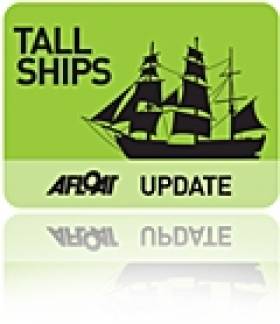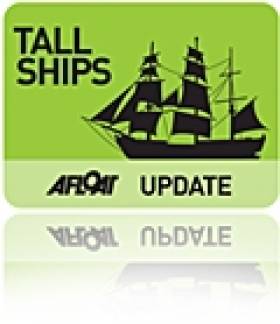Displaying items by tag: 'Parade of Sail'
More Tall Ships Head for Waterford
Waterford City will host day and night-time festivities, culminating with the 'Parade of Sail' on 3 July. On that day the fleet will set-sail down the Suir Estuary and head around Ireland's western seaboard on the first race leg bound for Greenock, Scotland.
The following 'Class A' (the largest tall ships) are so far confirmed: Christian Radich (Norway), Eendracht (Netherlands), Europa (Netherlands), Kaliakra (Bulgaria), Lord Nelson (UK), Pogoria (Poland), Royalist (UK) and the Wylde Swan from The Netherlands.
In 'Class B' vessels include the Jolie Brise, Maybe, Moosk, Provident, Swan, Spirit of Fairbridge, all from the UK. The category also includes Gedania (Poland), John Laing (UK), Ocean Spirit of Moray (UK) and Spaniel (Latvia) and two vessels from Belgium, the Rupel and Tomidi.
In addition the Dutch Urania is the first 'Class D' entrant to register for the Waterford event.
The Tall Ships Races is presented by Szczecin and organised by Sail Training International. Further information on participating as a sail trainee in The Tall Ships Races 2011 contact 051 849640 or www.waterfordtallshipsrace.ie and www.facebook.com/enjoywaterford
Looking for further reading on Tall Ships in Ireland? Click the links below:
Click this link to read all our Tall Ships Stories on one handy page
Previewing Ireland's Tall Ships 2011 Season
Can Ireland Get a New Tall Ship?
Waterford Tall Ships Races 2011 Participant Sails into Dublin
The Jubilee Sailing Trust's (JST) three-masted 'flagship' STS Lord Nelson arrived into Dublin today (Wednesday) as part of her sail-training programme. The barque is one of over 30 tall ships so far confirmed out of an expected 70 entrants for next year's Tall Ships Races starting from Waterford, writes Jehan Ashmore.
In the 'A' class tall ships (the large square-rigged vessels) the Lord Nelson will be sharing this category with a further six ships representing these impresssive vessels to include Christian Radich, Europa and the Polish Pogoria, which also called to Dublin recently.
The Lord Nelson will participate in the first race between Waterford and Greenock. From the Scottish port the tall ships will 'Cruise-In-Company' to Lerwick, the capital of the Shetland Islands. The race then crosses the North Sea to Stavanger, Norway and the final leg is to culminate in the Swedish west coast port of Halmstad in early August.
The Lord Nelson was designed by Colin Mudie and is specifically constructed to enable people of all physical abilities to sail side-by-side as equals. The vessel has an overall length of 54.7m and when under canvas (1,024m2) that's all 18 sails, Lord Nelson can achieve around 10 knots.
In addition to Lord Nelson, the JST which is run as a registered charity operates the SV Tenacious. Likewise this barque is designed for the same purpose and they can claim to be the only tall ships in the world having this distinction of providing sailing opportunities for all.
Since the charity started in 1978, over 36,000 people have sailed with the trust. Of those, over 24,000 people have sailed onboard Lord Nelson, which was launched in 1986, and 12,000 have sailed on Tenacious which was launched in 2000.
The countdown for the Waterford Tall Ships Races 2011 continues with less than 281 days to go!...The prestigious event is organised by Sail Training International in association with Szczecin.
Looking for further reading on Tall Ships in Ireland? Click the links below:
Click this link to read all our Tall Ships Stories on one handy page
Previewing Ireland's Tall Ships 2011 Season
Can Ireland Get a New Tall Ship?

























































